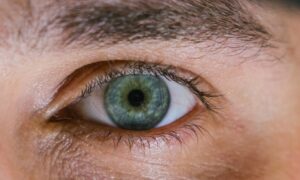Hidden No Longer, Eyes Reveal Rare Mental Condition
Australian researchers have made a breakthrough in a rare mental condition, aphantasia, that makes people unable to visualise images.Previously thought to be difficult to diagnose, researchers from the University of New South Wales (UNSW) have discovered a method for proving and diagnosing the rare mental condition via a person’s eyes’ responsiveness to light. Those who do not have aphantasia can visualize a bright and dark object, which evokes a visible pupillary reflex of contraction or dilation as it would if they walked out into the sun or into a dark room. Professor Joel Pearson the senior author of the paper publishing the results of the study said in a UNSW media release that this reflex exists in the human eye to optimize the amount of light hitting the retina. However, people with aphantasia can not visualize bright or dark objects so their pupils do not change. Pearson said that the results of the study provide the first physiological proof of aphantasia and establish an objective method of measuring visual imagery. “With over 1.3 million Australians thought to have aphantasia, and 400 million more internationally, we are now close to an objective physiological test, like a blood test, to see if someone truly has it.” The diagnosis method developed in the study revolves around this idea and is essentially a two-part eye test, monitored using fitted glasses that can track eye movements and pupil size. The study involved 42 participants who reported having a visual imagination and 18 with self-reported aphantasia. The first part of the test sets a baseline for the participants’ reactions by monitoring their eyes whilst they are shown bright and dark shapes on a grey background. In this part of the study both participants with aphantasia and those without had their pupils constrict in response to the bright objects and dilate in response to the dark objects. Part two of the test monitored the participant’s eyes when they are asked to think of a bright object and then a dark one, with their eyes open. Participants without aphantasia were able to visualise a bright or dark object and their pupils contracted or dilated correspondingly. Whereas participants with aphantasia were unable to imagine either a bright or dark object thus their pupils underwent no significant change. Researchers also noted that in the second portion of the test, the pupils of those who reported vivid visual imaginations were more enlarged than other participants. Pearson said that although there was knowledge of imagined objects causing endogenous changes in pupil size, it was surprising to see that the pupils of those with more vivid imagery changed more dramatically. Endogenous changes occur when a variable that is dependent on other variables in an experimental model is changed by an independent variable that is imposed on the model. “This really is the first biological, objective test for imagery vividness,” he said. “One of the problems with many existing methods to measure imagery is that they are subjective, that is to say they rely on people being able to accurately assess their own imagery.” Aphantasia impacts multiple areas of people’s lives, including the level of emotion that is felt when reading, how things are held in short term memory and the number of details in lifelong memories.(fizkes/Shutterstock) A potential flaw of this test was that a person who didn’t have aphantasia could simply not attempt to imagine a bright or dark shape and they would show up as lacking a visual imagination although they do not. The UNSW researchers addressed these issues by adding a third component to the study where participants were told to imagine one object and then four whilst their eyes were monitored with the glasses. “Our pupils are known to get larger when we are doing a more difficult task,” said Lachlan Kay, PhD candidate in UNSW’s Future Minds Lab. “Imagining four objects simultaneously is more difficult than imagining just one.” For both people with aphantasia and those without, the difficulty of the task was increased so, through monitoring the participant’s eyes, the researchers could see if the participants were actually attempting to fulfil their tasks. “The pupils of those with aphantasia dilated when they imagined four shapes compared to one, but did not change based on the whether the shapes were bright or dark.” Kay said that the pupils of the participants with aphantasia enlarging when they attempted a more difficult task showed that they were trying to imagine the shapes in the experiment but weren’t able to do it in a visual way. Pearson added that the pupil response in those with aphantasia as they were assigned the four objects task was another exciting find. “For the first time we have strong biological evidence that those with aphantasia are really trying to create a mental image, putting to rest claims that they may simply not be attempting to create a mental image,” he said. Over

Australian researchers have made a breakthrough in a rare mental condition, aphantasia, that makes people unable to visualise images.
Previously thought to be difficult to diagnose, researchers from the University of New South Wales (UNSW) have discovered a method for proving and diagnosing the rare mental condition via a person’s eyes’ responsiveness to light.
Those who do not have aphantasia can visualize a bright and dark object, which evokes a visible pupillary reflex of contraction or dilation as it would if they walked out into the sun or into a dark room. Professor Joel Pearson the senior author of the paper publishing the results of the study said in a UNSW media release that this reflex exists in the human eye to optimize the amount of light hitting the retina.
However, people with aphantasia can not visualize bright or dark objects so their pupils do not change.
Pearson said that the results of the study provide the first physiological proof of aphantasia and establish an objective method of measuring visual imagery.
“With over 1.3 million Australians thought to have aphantasia, and 400 million more internationally, we are now close to an objective physiological test, like a blood test, to see if someone truly has it.”
The diagnosis method developed in the study revolves around this idea and is essentially a two-part eye test, monitored using fitted glasses that can track eye movements and pupil size. The study involved 42 participants who reported having a visual imagination and 18 with self-reported aphantasia.
The first part of the test sets a baseline for the participants’ reactions by monitoring their eyes whilst they are shown bright and dark shapes on a grey background. In this part of the study both participants with aphantasia and those without had their pupils constrict in response to the bright objects and dilate in response to the dark objects.
Part two of the test monitored the participant’s eyes when they are asked to think of a bright object and then a dark one, with their eyes open. Participants without aphantasia were able to visualise a bright or dark object and their pupils contracted or dilated correspondingly. Whereas participants with aphantasia were unable to imagine either a bright or dark object thus their pupils underwent no significant change.
Researchers also noted that in the second portion of the test, the pupils of those who reported vivid visual imaginations were more enlarged than other participants.
Pearson said that although there was knowledge of imagined objects causing endogenous changes in pupil size, it was surprising to see that the pupils of those with more vivid imagery changed more dramatically.
Endogenous changes occur when a variable that is dependent on other variables in an experimental model is changed by an independent variable that is imposed on the model.
“This really is the first biological, objective test for imagery vividness,” he said. “One of the problems with many existing methods to measure imagery is that they are subjective, that is to say they rely on people being able to accurately assess their own imagery.”

A potential flaw of this test was that a person who didn’t have aphantasia could simply not attempt to imagine a bright or dark shape and they would show up as lacking a visual imagination although they do not.
The UNSW researchers addressed these issues by adding a third component to the study where participants were told to imagine one object and then four whilst their eyes were monitored with the glasses.
“Our pupils are known to get larger when we are doing a more difficult task,” said Lachlan Kay, PhD candidate in UNSW’s Future Minds Lab. “Imagining four objects simultaneously is more difficult than imagining just one.”
For both people with aphantasia and those without, the difficulty of the task was increased so, through monitoring the participant’s eyes, the researchers could see if the participants were actually attempting to fulfil their tasks.
“The pupils of those with aphantasia dilated when they imagined four shapes compared to one, but did not change based on the whether the shapes were bright or dark.”
Kay said that the pupils of the participants with aphantasia enlarging when they attempted a more difficult task showed that they were trying to imagine the shapes in the experiment but weren’t able to do it in a visual way.
Pearson added that the pupil response in those with aphantasia as they were assigned the four objects task was another exciting find.
“For the first time we have strong biological evidence that those with aphantasia are really trying to create a mental image, putting to rest claims that they may simply not be attempting to create a mental image,” he said.

Rebecca Keogh PhD, Macquarie University research fellow and another author of the study, said that in regards to memory and aphantasia the findings of the study are very interesting.
“Our previous work has shown that aphantasic individuals are able to perform visual working memory tasks, remembering many images for a short period of time, without using visual imagery,” Keogh said.
“These findings further highlight the wide variability of the human mind that can often remain hidden until we ask someone about their internal experiences or invent new ways to measure the mind,” she said. “It reminds us that just because I remember or visualise something one way, doesn’t mean everyone does.”
Following the study, Pearson and his team intend to develop and run an online test based on the one used in the study to provide a globally available and effective way of measuring people’s capacity for visual imagery.
“This really is an exciting time,” said Pearson. “We are very close to having objective, reliable tests for extreme imagery, aphantasia and hyperphantasia (extremely strong visual imagery) that could be scaled up to run online for millions of people everywhere.”
Aphantasia impacts multiple areas of people’s lives, including the level of emotion that is felt when reading, how things are held in short term memory and the number of details in lifelong memories said, Pearson.
“This new method will allow us to understand the brain mechanisms of extreme imagery and the global implications for how we think, make decisions and feel,” he said.












